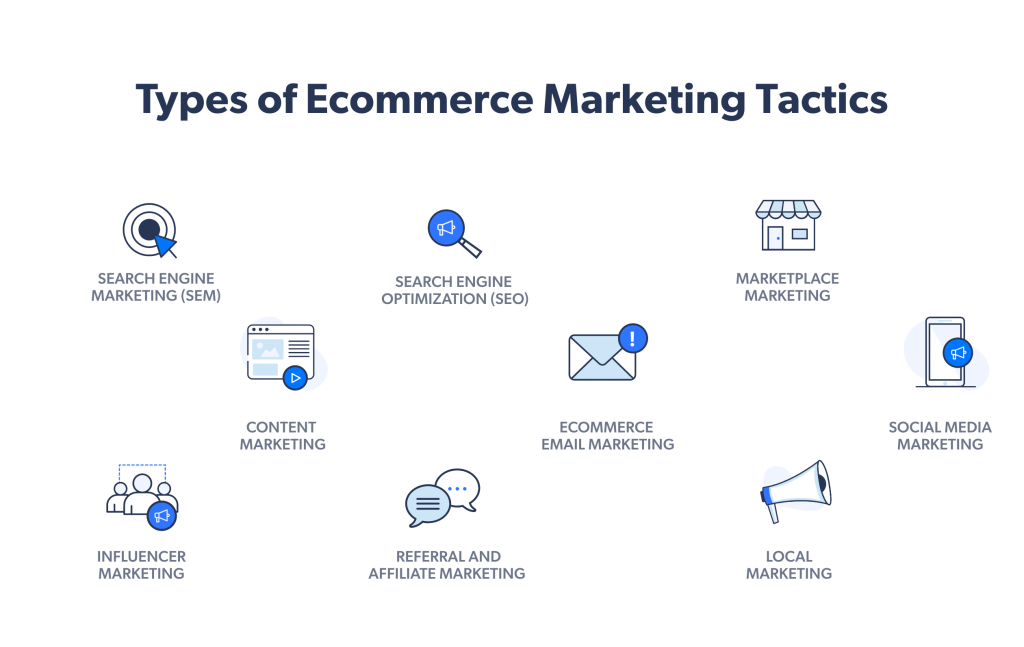By Tony Huynh | July 17, 2020

See why top ecommerce brands use Miva’s no-code platform to run
multiple stores, manage massive catalogs, and grow their revenue.
Table of Contents:
If you have an online store, your key goals may be to increase traffic and boost sales. Unfortunately, the phrase “if you build it, they will come” doesn’t hold true in ecommerce. To succeed as an online merchant and maximize the viability of your digital storefront, you will need to create an effective marketing strategy. Doing so will help you acquire visitors and retain them as loyal customers, boosting the profitability of your business.
In this guide, we dive into the key elements of ecommerce marketing and discuss how to market your online brand in the right way and to the right people. Whether you are new to ecommerce or are looking to build more awareness for your store, we’ll show you how to master ecommerce marketing and create strategies that set your business up for long-term success.
Ecommerce marketing involves using online channels to increase awareness for your online store. While a brick-and-mortar business may rely on a physical location to bring in traffic, ecommerce businesses take advantage of various online channels to reach potential customers and send them targeted messages.
At its core, ecommerce marketing is about bringing traffic to your store and turning that traffic into sales. Successful ecommerce stores typically use a mix of media and strategies to meet the goals outlined for their business.
To thrive in an increasingly crowded and turbulent commercial environment, online merchants need marketing to expand their reach, grow their online sales, and keep their competitive edge. Ecommerce marketing offers a way to find relevant customers for your online store, encourage them to make purchases, and turn them into loyal, happy customers that will continue to fuel your business in the long run.
An ecommerce marketing strategy serves as a roadmap for promoting your business and keeps your team on the same page. It details which tactics you’ll use, outlines the goals you’ll strive for, and determines how you’ll allocate your resources.
A thought-out action plan guides your marketing efforts and helps you make the right decisions to achieve ecommerce success. While marketing strategies can vary between companies, every strategy should take into account a business’ goals and objectives (based on industry benchmarks), value proposition, target personas, and the channels that will be used to communicate with the public.
No marketing strategy is fixed. As marketing tactics evolve and consumer needs change, your strategy must provide room for you to pivot so you can achieve the highest return on investment.
Ecommerce advertising allows you to send direct messages to an interested audience—examples include display ads, shopping feed placements, and paid social media campaigns. Compared to other forms of ecommerce marketing, which generally take time to build up momentum, ecommerce advertising can generate fast results and bring traffic to your site.
When you use ecommerce advertising in tandem with other ecommerce marketing channels, your business will be able to reach a wider audience while improving your brand awareness and customer engagement.
Choosing the right ecommerce marketing tactics and strategies will be critical to your online success. Here are some digital marketing channels that ecommerce marketers use to boost traffic, attract visitors, encourage purchases, and generate repeat business.

For many online stores, search engine marketing (SEM) serves as a key channel for acquiring new customers. Marketers can spend resources toward pay-per-click ads that place their store above organic results, boosting their visibility and getting visitors to land on their website and take action.
How to Get Started: Conduct keyword research on the most valuable keywords for your industry. Start small with a few campaigns to provide a baseline for analyzing results.
Advanced Tactic: Consider your target audience’s broader needs and interests. For example, if you sell fitness equipment, try to instead target searches around nutrition information and post-workout recipes. You may find potential customers among those who are investigating highly relevant topics.
Further Reading: HubSpot provides a great guide on search engine marketing and how to use this channel effectively for your business.
Search engine optimization (SEO) is an essential component of any online strategy. SEO focuses on meeting the requirements of both search engines and users to make your site searchable, relevant, and easy to use. SEO goes hand-in-hand with SEM to improve the visibility and sales potential of your online store.
How to Get Started: Conduct research on the keywords your customers are searching for. Make sure your entire site and individual product pages are optimized for these words.
Advanced Tactic: Build backlinks to your store from reputable websites. Link-building not only sends interested traffic to your site but also signals to search engines that other sites trust yours, generating valuable SEO “juice” to boost your rankings.
Further Reading: To get the most of your SEO, check out our whitepaper how to create a search-centric strategy that drives traffic and boost sales.
An online marketplace is an ecommerce site where merchants, sellers, brands, and vendors can sell their products. With their large pre-existing customer base and extensive reach, marketplaces like Amazon and eBay can serve as a springboard for collecting new traffic and capturing attention from customers who might not have come across your brand otherwise. Your ecommerce site can sell alongside Amazon as a hybrid engine for generating brand awareness and building customer loyalty.
How to Get Started: Create a seller account on a marketplace like Amazon. Make sure your product listings have keyword-rich titles, compelling product descriptions, and high-quality images.

Advanced Tactic: Use Fulfilled by Amazon sponsored ads to expand the reach of your listings. Optimize your Amazon-branded storefront to increase opportunities for exposure.
Further Reading: What’s next after creating your Amazon storefront? Learn how to use your Amazon ranking to boost your brand and your Amazon product listings to drive traffic to your own website.
The term “content marketing” encompasses multiple forms of media, including video, product pages, blog posts, and more. Content marketing is used to build authority, attract traffic, and develop trust with your customers—all things that contribute to the success of an online store.
How to Get Started: Plan out your content strategy by determining the types of content you want to create, the goals you want to achieve, and how you will get your content in front of your target audience.
Advanced Tactic: Create informational blogs on topics related to your industry. Browse Google to see what kind of topics customers are searching for and write content that addresses popular questions and problems.
Further Reading: Marketing starts with a solid foundation. Learn here how to create an evergreen content strategy that connects with and engages customers.
Email marketing is a low-cost, high return-on-investment tool that lets you deliver targeted messages to prospective and existing customers and provide unique special offers that they can’t get anywhere else. Some of the most successful companies use email marketing to connect with their audience and generate revenue.
How to Get Started: Collect customer emails on your site with a pop-up. Send new subscribers a coupon code to drive sales and establish an positive relationship. Leverage great visuals, compelling copy, and strong branding to create a good first impression with your emails.

Advanced Tactic: Implement an automated email campaign to reengage an audience based on an action they took on your website and turn them into customers. A good segment to start with is your cart abandoners. Send them a campaign that emphasizes your key differentiators to reestablish your relationship and offer a special coupon or free shipping to encourage them to convert.
Further Reading: Check out our step-by-step guide on how to build out your abandoned cart emails.
Social media is a valuable ecommerce channel for not only building and nurturing relationships with your customers but also for driving sales. You can use social networks to curate content that supports your brand, encouraging awareness and communicating your business’ unique value. This combination engages users and attracts attention from potential customers.
How to Get Started: Create online business pages on Facebook and Instagram. Post your most popular products with eye-catching visuals and leverage hashtags to increase your visibility.
Advanced Tactic: Boost your most popular posts to expand your audience and drive traffic to your site. This creates future opportunities for retargeting these users with paid social media ads to drive conversions and sales.
Further Reading: Learn how to hack your social media advertising to inspire action from your audience.
Influencer marketing focuses on using the influence of other people and brands to boost awareness and encourage your target audience to take action on your site. Since influencers often have more trust and engagement with their followers, this channel offers a meaningful, personal way to connect with a relevant audience.
How to Get Started: Make a list of relevant hashtags for your industry and use them to seek out potential influencers. Consider asking your social media following about their favorite public figures. Research these influencers to understand their audience and the level of engagement you can expect from a partnership.
Advanced Tactic: Consider partnering with your chosen influencers and other brands on a special giveaway, contest, or collaborative campaign to further expand your customer acquisition.
Further Reading: Influencer marketing is constantly changing. Check out HubSpot’s guide on the best ways to work with social media influencers in 2020 and beyond.
Many ecommerce brands employ referral marketing and affiliate marketing. Referrals involve word-of-mouth marketing from your customers, while affiliates are people that help promote your product in return for a commission. Both referral and affiliate marketing can be low-cost ways to bring in new customers.
How to Get Started: Reach out to your best customers and make a list of affiliates you’d like to work with to test out the waters.
Advanced Tactic: Consider launching a formal referral program on your website. Offer your best customers incentives for referring their friends and publicize your program to your loyal customers via an email and social media campaign.
Further Reading: Learn how to use referrals to win word-of-customer exposure and grow your online business.
Depending on your business, local marketing can be highly effective for targeting areas where your buyers are concentrated. This enables you to reach a specified audience and attract new customers through more personalized messaging and localized special offers.
How to Get Started: If you have a physical address for your business, you can claim a local listing on a search engine like Google or Bing and include information like your address, hours, phone number, and business pictures.
Advanced Tactic: Use website cookies to see where you have large concentrations of customers, then leverage social media to target users in specific areas and extend special offers to those locations.
Further Reading: Make sure your site is optimized for local searches. Check here to see if your site is mobile enough for users.
Now that you are familiar with some of the channels that marketers use, it’s time to lay the groundwork for your own ecommerce marketing efforts. Planning out your strategies helps to clarify your direction and propel your business forward. Here are steps you can take to create your marketing strategies.
When building your marketing plan, there a few questions you want to ask yourself to create a strong foundation:

There are many different tactics that online merchants can use to promote their business. Marketers often use these channels in conjunction with each other to meet their defined goals. What you want to do is to create a strong foundation and then build from there. To achieve this, sellers often form their strategies around the following endeavors:
Increasing Visibility
Increasing visibility allows your business to get creative, communicate to buyer needs, and create demand for your products or services, which ultimately leads to more sales.
Building Your Brand
Good branding sets you apart in an increasingly competitive market. Modern ecommerce shoppers often buy a product or service for a brand and what it stands for.
Forging Customer Connections
Customers are more likely to purchase from brands that they have a connection with. Forging this connection requires earning your customers’ trust and providing them a reason to come back to your brand.
Creating a Community
This is the stage where you can apply strategies to retain customers and increase their lifetime value. Having a “tribe” of customers serves a valuable function for your business—dedicated users are more likely to engage with your business, repurchase, and refer other customers to your business.
While it’s important to focus on the right marketing strategies, successful ecommerce marketing is all about sending the right message to the right person at the right time. Not all your target customers will be at the same stage—some may be ready to purchase from you, while others are just barely familiar with your brand.
Understanding the ecommerce marketing funnel—and where your target customers fall in that funnel—allows you to more effectively promote your business. Let’s dive into the five stages in the marketing funnel and explore what your priorities should be for each one.
In this stage, visitors to your site are aware of their needs and may show interest in your products, but they are not yet familiar with your brand and the unique value it offers. Brands often leverage social media posts, video content, and informative blogs to educate customers and build their trust during this stage.
Visitors in this stage have discovered a need or pain point and are looking for ways to address those needs. This is where brands highlight their unique value proposition and provide content like whitepapers, guides, newsletters to both address customer problems and suggest their products as a solution.
Customers here are more aware of your company—possibly considering you as a top candidate. They are ready to purchase, but may need additional convincing that you’re the right company. Here, businesses need to show they provide more value than the competition and communicate their differentiators.
In this stage, prospective customers turn into purchasers when they go to complete a transaction on your site. This stage can be tricky, as a subpar purchase experience can lead to cart abandonment and lost sales. A great purchase experience, on the other hand, can turn a one-time shopper into a loyal customer.
In this stage, customers have already purchased from you before and like your experience enough that they want to purchase again. These users can potentially become brand advocates who will share valuable social proof about your company, products, and services. A great way to foster retention is to reward your VIP customers and send them exclusive offers and deals.
There are many different things that go into a successful ecommerce marketing strategy. To market effectively, you will need to understand your audience and have a clear view of your goals. This will allow you to choose the right channels and strategies that will drive real results for your business.
Once your strategy is dialed in, give your marketing a jumpstart by collecting emails, establishing a channel for traffic, and creating content to boost your brand awareness. Take a look at our guide on How to Create a Profitable Ecommerce Marketing Engine and The Resilient Retailer’s Survival Guide for more marketing and branding strategies.
Love it? Share it!
No worries, download the PDF version now and enjoy your reading later...
Download PDF Tony Huynh
Tony Huynh
Tony Huynh is the Senior Content Marketing Specialist at Miva, Inc. Tony is a regular contributor to the Miva blog, covering ecommerce topics like site optimization, ecommerce marketing, and business transformation. He brings to Miva a combination of in-house ecommerce and digital agency experience, with the goal of addressing the needs of online sellers and helping them to succeed online.
Visit Website